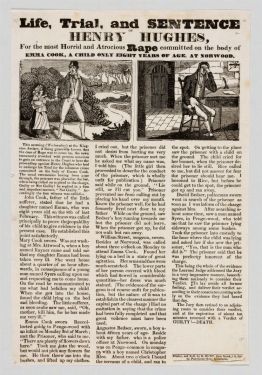During the 1800s the conviction and punishment of criminals was fundamentally different from today, for example public hangings were a very regular affair, with crowds of over 10,000 plus. These crowds varied in different class, with the upper class seeing the whole hanging aspect as some form of ‘entertainment’. Inevitably this meant that the themes of crime, conviction and punishment became hugely popular. Alongside it came the criminal ‘broadside’. The broadside was one single side of paper, which usually contained information about the execution of a criminal from different perspectives with varied levels of accuracy. Additionally, these broadsides also included illustrations. The broadside itself was one of the very limited accessible forms of literature available to the ‘ordinary’ people and if they were any good then lots would be sold.

This is the first criminal broadside published for the trial and sentencing of accused rapist, Henry Hughes.
Sometimes if the crime was completely and utterly shocking there would be just more than one broadside written. My example which backs up this point is the case of a man named Henry Hughes, who was convicted in 1834 for the rape of Emma Cook, who was just eight years old. Consequently, two broadsides were produced, one for the trial and one for the execution. The broadsides themselves were both sold and printed by completely different persons and contained clear differences. One startling different is that the second broadsides refers to the victim as ‘Emma Cock’, whereas the first broadsides states the victims name as ‘Emma Cook’. The obvious mistake here heightens just how rushed these broadsides were.
A similarity of the two broadsides is something that draws the attention of the reader straight away and this is the headline. Both broadsides use bold writing and capitals, emphasising just how much of a big deal this is. Additionally, both include an image under the headline, this would be to draw the attention of the reader as it looks much more attractive than just a piece of writing on a page.

This broadside is the second one published for the trial and execution of Henry Hughes. However, there is one significant difference as this one refers to the victim as ‘Emma Cock’, as opposed to her real name ‘Emma Cook’.
Another difference between the broadsides is that the first broadside claims how the jury only took ‘ten minutes’ to convict Henry Hughes as guilty, whereas the second one states how the jury took ‘upwards of an hour’. This different between the two again reinforces my previous point of just how unreliable the broadsides were. Broadsides were used in order to make the audience feel somehow connected to the events which took place, in this case the rape of an eight year old girl.
Works Cited: